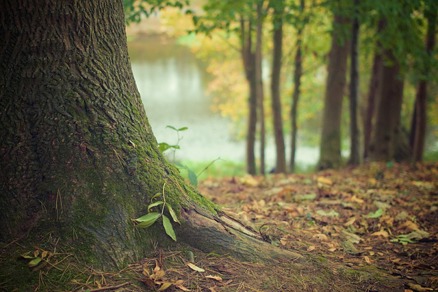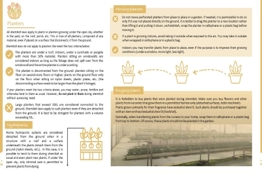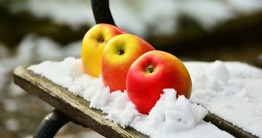Trees that self-seeded during shemitah

Can I leave in my garden a tree that self-seeded during shemitah? Can I move it after shemitah to a different location?
Question:
I discovered that a fig tree sprouted in a planter outside my window. I'm not sure how; perhaps a seed blew there from somewhere. Do I need to uproot the tree? If not, may I plant it in the ground now, after shemitah, even if I plant it with its clod of soil so that the orlah count continues from its original date of self-seeding?

Sefichin
The sefichin prohibition, forbidding plants that self-seeded during shemitah, applies only to annual plant that Chazal were concerned people would plant to eat during the shemitah year. However, Chazal were not worried that people would plant trees (or other perennial plants) whose fruit could only be eaten in another three years. Thus, the sefichin prohibition does not apply to your fig tree.
Uprooting Trees and the Orlah Count Decree (gezeirat monim)
The Mishnah (Terumot 2:3) states: "One who plants on Shabbat: If unwittingly (shogeg), he may keep the tree. But if intentionally (mezid), he must uproot it. But if during the sabbatical year, whether [it was planted] unwittingly or intentionally he must uproot it."
The Gemara (Gittin 53b based on Tosefta Shabbat 2:21) distinguishes between Shabbat, where only if a tree is planted intentionally it must be uprooted, and shemitah where regardless if planted intentionally or unintentionally, the tree should be uprooted, for two reasons:
First, the orlah count will start at the shemitah year. That is, it will seem strange that the first orlah year is during shemitah.[1] For this reason, Chazal forbid tree even if planted unintentionally, but only for fruit trees subject to the laws of orlah and not non-fruit trees and vegetables.
The second explanation for this is that Jews are suspected of desecrating shemitah but not Shabbat. For this reason, only during shemitah is a fine imposed even on those who plant unintentionally. Following this rationale, the obligation to uproot would apply to any plant.
In practice, Rambam is stringent following both rationales: on the one hand, he requires uprooting trees planted before shemitah if the tree's first orlah year will be shemitah (Hilchot Shemitah 3:11), but explicitly states (ibid., 1:12) that the reason for this is due so suspicion:
When a person plants [crops] during the Sabbatical year whether in inadvertent or willful violation, he should uproot them, because the Jews are suspect with regard to [the prohibitions of the] Sabbatical year. If we would allow a person who [sowed] inadvertently to keep the crops, a person who [sowed] intentionally would say: "I did so inadvertently."
From here we can learn that any crop sowed or planted during shemitah must be uprooted, even when not subject to orlah laws. See also an article (in Hebrew) by Rabbi Itzhak Dvir, "Benefit and care for results of forbidden actions performed during shemitah," Emunat Itecha 134 (5782).
This discussion at hand relates to a tree planted in a forbidden way. What happens if a tree is planted in a permitted manner? Certainly there is no prohibition involved, it is permitted to care for it, and even transplant it later on. Furthermore, there is no concern that the first orlah year is shemitah since it was planted in a permitted fashion.
Examples of permissible planting during shemitah
- If a non-Jew plants a tree during shemitah in his own land and then transplants the tree to a Jew's land in its clod of soil during the eighth year, it does not present an orlah count problem.
- If a Jew planted in a nursery on a detached surface in a permitted manner during shemitah, and during the eighth year wants to transfer the tree to another place where it will continue to be detached from the soil (this is common with blueberry bushes, which are generally grown on detached platforms). This is permissible and the orlah years will continue from the date of planting during shemitah, despite the fact that the first orlah year will be the shemitah
- A self-seeding tree (seed carried by the wind or by an animal)
- A tree planted by a non-Jew during shemitah through heter mechirah in a greenhouse and the trees are to be transported to farmers for transplant in their fields during the eighth year. This is a very practical issue. For those who rely on heter mechirah, it seems that the initial planting was permitted and thus it will be possible to continue the orlah This is what many farmers actually do: they buy trees that are two years old from a supervised nursery and make sure that during the transfer to the orchard, the various halachot are observed allowing the orlah count to continue. Then, it will be possible to "save" one year's worth of produce and to sell fruit two years after the trees are planted in the farmer's orchard (4th year of the tree).
However, Rabbi Kook forbid planting new trees during the shemitah year or even commissioning a non-Jew to do so. For this reason, Torah VeHa'aretz Institute does not permit nurseries under its supervision to produce saplings during shemitah, not even by a non-Jew after heter mechirah was performed. Rabbi Yosef Efrati also is very strict about this point. For this reason, farmers cannot buy such saplings from nurseries supervised by Torah VeHa'aretz Institute to plant during the eighth year
(note that it is possible that Rabbi Kook would permit this in today's nurseries: Rabbi Kook spoke about planting trees and maintained that there is no need to do so during shemitah since it is possible to plant the next year (or the year before); in today's nurseries, however, saplings are produced every year. They produce large quantities of saplings for farmers to plant during the eighth year; however, they do produce saplings every year so it does not seem, as Rav Kook claims, that it can be pushed off until the next year, or done the year before. However, in practice we do not permit this, yet there may be rabbis who are lenient).
- A tree planted during shemitah outside of Israel and is transplanted to Israeli soil. Here the halachah is different, since the prohibition of orlah in the Land of Israel is biblical, while abroad it is only a halachah leMoshe miSinai, which is a lower-level obligation. For this reason, when transplanted the orlah count starts again. However, Rabbi Yoel Friedemann rules that if the tree was initially planted outside of Israel in an unperforated planter and transferred to Israel in an unperforated planter (the orlah obligation for trees growing in unperforated planters is rabbinic according to most posekim), the level of obligation is the same so it will be possible to continue the orlah count from the time of planting even though it was planted during
[1] In the words of the Gemara:
It is because Jew count [the tree's years] from the Sabbatical year, but they do not count from Shabbat. Alternatively: Jews are suspected of desecrating the Sabbatical Year, but they are not suspected of desecrating the Shabbat. Why [is the] alternative [mentioned as well?]: This is what [Rabbi Meir] is saying: And if you would say Jews also count from Shabbat [as at] times the thirtieth day before [Rosh Hashanah] falls on Shabbat. As, if he planted on that day, it counts for him as a year. And if not [i.e. he planted the next day] it does not count for him [as a full orlah year.] [Consequently, the addition]: come and hear that alternatively, Jews are suspected of desecrating the Sabbatical year, but not suspected of desecrating the Shabbat.




